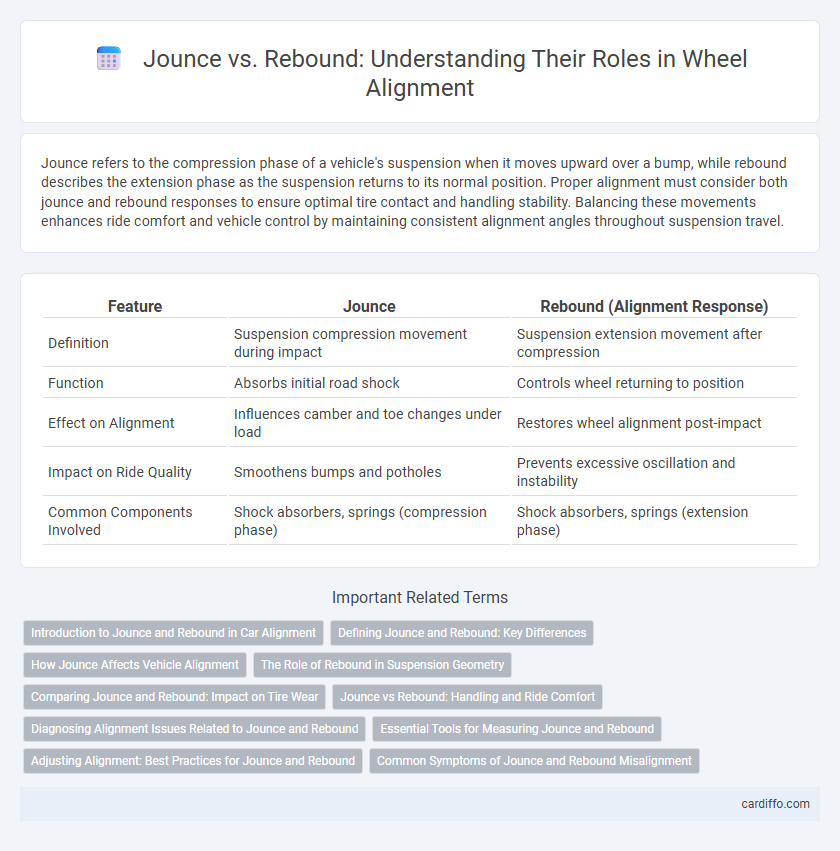Jounce refers to the compression phase of a vehicle's suspension when it moves upward over a bump, while rebound describes the extension phase as the suspension returns to its normal position. Proper alignment must consider both jounce and rebound responses to ensure optimal tire contact and handling stability. Balancing these movements enhances ride comfort and vehicle control by maintaining consistent alignment angles throughout suspension travel.
Table of Comparison
| Feature | Jounce | Rebound (Alignment Response) |
|---|---|---|
| Definition | Suspension compression movement during impact | Suspension extension movement after compression |
| Function | Absorbs initial road shock | Controls wheel returning to position |
| Effect on Alignment | Influences camber and toe changes under load | Restores wheel alignment post-impact |
| Impact on Ride Quality | Smoothens bumps and potholes | Prevents excessive oscillation and instability |
| Common Components Involved | Shock absorbers, springs (compression phase) | Shock absorbers, springs (extension phase) |
Introduction to Jounce and Rebound in Car Alignment
Jounce and rebound are critical concepts in car alignment, referring to the suspension's vertical movement during compression and extension, respectively. Jounce occurs when the wheel moves upward as the suspension compresses, while rebound happens when the suspension extends, allowing the wheel to travel downward. Proper understanding and adjustment of jounce and rebound ensure optimal tire contact with the road, improving vehicle stability and handling.
Defining Jounce and Rebound: Key Differences
Jounce refers to the vertical displacement and its rate of change in a vehicle's suspension system, measuring how quickly the suspension compresses or rebounds during road irregularities. Rebound, on the other hand, specifically describes the suspension's extension or return after compression, crucial for maintaining tire contact and vehicle stability. Understanding the differences between jounce and rebound aids in optimizing vehicle alignment settings for improved handling and ride comfort.
How Jounce Affects Vehicle Alignment
Jounce directly impacts vehicle alignment by causing suspension components to compress and extend, which alters camber, caster, and toe angles during driving. This vertical movement shifts the wheel position relative to the chassis, influencing tire contact patch and vehicle handling. Properly tuning jounce helps maintain optimal alignment settings, ensuring stability and tire longevity.
The Role of Rebound in Suspension Geometry
Rebound in suspension geometry crucially influences vehicle stability by controlling the extension of the suspension after compression, directly impacting wheel alignment and tire contact with the road. Proper rebound tuning maintains optimal camber angles during dynamic loads, reducing tire wear and enhancing grip through consistent traction. This adjustment ensures balanced handling characteristics, particularly in managing how the suspension returns to its neutral position after encountering bumps or road irregularities.
Comparing Jounce and Rebound: Impact on Tire Wear
Jounce refers to the compression phase when the suspension moves upward, directly affecting tire contact and load distribution, while rebound is the extension phase where the suspension returns to its normal position, influencing tire grip and stability. Excessive jounce can lead to uneven tire wear on the inner edges due to increased load concentration, whereas improper rebound settings often cause outer tire wear from reduced traction and instability. Optimizing both jounce and rebound alignment parameters ensures balanced tire wear, improved handling, and enhanced suspension performance.
Jounce vs Rebound: Handling and Ride Comfort
Jounce and rebound significantly influence vehicle handling and ride comfort by controlling suspension articulation during compression and extension phases. Optimizing jounce stiffness improves road contact and reduces body roll, enhancing stability and steering precision, while balanced rebound damping prevents excessive oscillation and improves shock absorption. Effective calibration of both jounce and rebound rates ensures a smooth ride and responsive handling, crucial for maintaining vehicle dynamics on varying road surfaces.
Diagnosing Alignment Issues Related to Jounce and Rebound
Diagnosing alignment issues related to jounce and rebound involves examining the suspension's behavior during compression and extension cycles, as these vertical movements directly impact wheel alignment angles. Misalignment can occur when jounce causes excessive camber changes or toe variations, while rebound may lead to improper steering geometry and uneven tire wear. Accurate diagnosis requires measuring dynamic alignment parameters under both conditions to identify suspension inconsistencies affecting vehicle stability and handling.
Essential Tools for Measuring Jounce and Rebound
Essential tools for measuring jounce and rebound in suspension alignment include high-precision displacement sensors and velocity transducers, which capture the vertical wheel travel and speed accurately. Force plates and load cells measure the dynamic forces during compression (jounce) and extension (rebound) cycles, providing critical data for suspension tuning. Advanced data acquisition systems integrate these measurements, enabling real-time analysis of suspension response for optimized vehicle alignment and ride quality.
Adjusting Alignment: Best Practices for Jounce and Rebound
Adjusting alignment for jounce and rebound requires precise calibration to ensure optimal suspension performance and vehicle stability. Best practices include using alignment tools to measure camber, caster, and toe angles during compression (jounce) and extension (rebound) of the suspension, thereby maintaining consistent tire contact with the road. Consistent monitoring and adjustment of these parameters reduce uneven tire wear and improve handling dynamics in various driving conditions.
Common Symptoms of Jounce and Rebound Misalignment
Common symptoms of jounce misalignment include uneven tire wear, steering wheel vibration, and suspension noise during compression, indicating improper vertical movement of the suspension components. Rebound misalignment often presents as poor vehicle stability, excessive body roll, and difficulty controlling the vehicle after hitting a bump, revealing compromised suspension extension response. Both conditions lead to decreased handling performance and increased risk of premature suspension component failure.
Jounce vs Rebound (Alignment Response) Infographic

 cardiffo.com
cardiffo.com